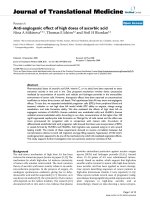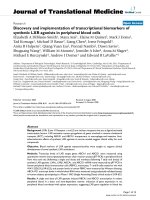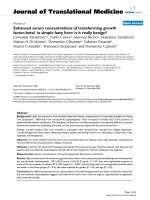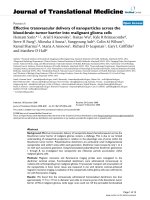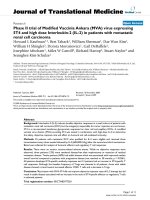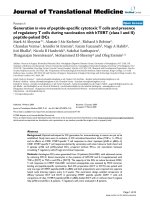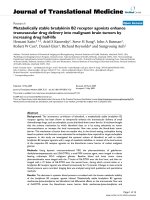Báo cáo hóa học: " High-Temperature Stable Operation of Nanoribbon Field-Effect Transistors" pot
Bạn đang xem bản rút gọn của tài liệu. Xem và tải ngay bản đầy đủ của tài liệu tại đây (442.08 KB, 5 trang )
NANO EXPRESS
High-Temperature Stable Operation of Nanoribbon Field-Effect
Transistors
Chang-Young Choi
•
Ji-Hoon Lee
•
Jung-Hyuk Koh
•
Jae-Geun Ha
•
Sang-Mo Koo
•
Sangsig Kim
Received: 29 June 2010 / Accepted: 19 July 2010 / Published online: 3 August 2010
Ó The Author(s) 2010. This article is published with open access at Springerlink.com
Abstract We experimentally demonstrated that nanorib-
bon field-effect transistors can be used for stable high-
temperature applications. The on-current level of the
nanoribbon FETs decreases at elevated temperatures due to
the degradation of the electron mobility. We propose two
methods of compensating for the variation of the current
level with the temperature in the range of 25–150°C,
involving the application of a suitable (1) positive or (2)
negative substrate bias. These two methods were compared
by two-dimensional numerical simulations. Although both
approaches show constant on-state current saturation
characteristics over the proposed temperature range, the
latter shows an improvement in the off-state control of up
to five orders of magnitude (-5.2 9 10
-6
).
Keywords Field-effect transistors (FETs) Á
Electron mobility Á Variation of the current level Á
Nanoribbon FET
Introduction
The nanoribbon structure has recently been extensively
investigated for many applications, such as ZnS nanorib-
bon lasers [1], graphene nanoribbon field-effect transistors
(GNRFETs) [2], nanoribbon sensors in Si [3] and other
materials [4]. Nanoribbon structures offer a relatively easy
system to access, control and process, due to their rela-
tively larger scale compared to other nanostructures, such
as nanowires (NWs) [5], nanodots (NDs) [6] and nanotubes
(NTs) [7]. Nanoribbons or thin silicon on insulators have
many advantages, such as low leakage and a high on/off
current ratio, I
ON
/I
OFF
, which leads to low power con-
sumption while the device is inactive [8]. In addition, since
their parasitic capacitance is effectively eliminated by the
underlying insulating layer, nanoribbon- or thin silicon-
based devices have advantages for RF applications [9].
Such structures also have a lower threshold shift in
response to temperature variations [10–13]. However, the
reduction in mobility induced by the thermal scattering
causes the operation points of the device to vary with the
temperature. This temperature-dependent variation of the
operation points makes the devices hard to operate prop-
erly. [14] For some high-temperature circuits, it is desirable
that the individual devices have a specific operation point
where the device characteristics show no variation with
temperature. In this work, we demonstrate the feasibility
of the constant operation of the fabricated devices in
the temperature range from 25 to 150°C. The method
employed to achieve the constant operation of the fabri-
cated devices, which is similar to zero temperature coef-
ficients (ZTC), is based on the use of a substrate bias
(V
SUB
). By accumulating or depleting the carriers on the
channel surface using the substrate bias (V
SUB
), we show
that the device on/off characteristics show minimal varia-
tion with temperature.
Experimental
A 30-nm-thick p-type silicon on insulator (SOI) wafer has
been used as the starting material, and the SOI layer has
C Y. Choi Á J H. Lee Á J H. Koh Á J G. Ha Á S M. Koo (&)
College of Electronics and Information Engineering,
Kwangwoon University, Seoul 139-701, Korea
e-mail:
S. Kim
Department of Electrical Engineering, Korea University, Seoul
136-701, Korea
123
Nanoscale Res Lett (2010) 5:1795–1799
DOI 10.1007/s11671-010-9714-y
been thinned down to 20 nm by oxidation. The length L
CH
and width W
CH
of the channels, defined by conventional
lithography, were 30 and 10 lm, respectively. The thick-
ness (t
OX
) of the gate oxide was 40 nm, and n
?
poly silicon
was used as the gate electrode. Au/Al was used as the metal
electrodes for the source, drain, gate, and substrate con-
tacts. Figure 1 shows a schematic representation of the
fabricated nanoribbon device. The electrical characteristics
of the devices were measured by an HP4155b semicon-
ductor parameter analyzer with a hot chuck for elevated
temperature measurements. To diffuse the heat over the
whole device at each temperature, the device was heated
for a long enough time before each measurement.
We used a substrate bias (V
SUB
) to ensure the constant
operation of the devices at elevated temperatures, and the
measurements were compared with the two-dimensional
simulation results obtained from structures identical to
those of the fabricated devices [15]. In order to evaluate the
substrate and top bias-dependent channel carrier modula-
tion as a function of temperature, we extracted the channel
cross-section profiles containing the on- and off-current
density distribution at different temperatures.
Results and Discussion
Figure 2a shows the gate transfer characteristics of the
fabricated (solid lines) and simulated (dashed lines) nano-
ribbon FET structures. The current level decreases as the
temperature increases, which is ascribed mainly to the
influence of lattice scattering caused by the elevated tem-
perature on the mobility decay. Figure 2b shows the decays
in the normalized saturation current level and mobility
values at different temperatures. Both the simulated and
measured current levels and therefore the mobility values
follow the power-law decay behavior (µ T
-1.5
). Note that
the mobility values presented in Fig. 2 do not have a unit
but instead show relative degradation ratio with respect to
the room temperature value. Such mobility degradation,
where lattice scattering is the dominant scattering mecha-
nism, can be expressed by a power law [16]. This variation
of the current level or mobility can make the device dif-
ficult to use in high-temperature or temperature-variable
ambient applications.
To overcome such a thermal problem, which may result
in the variation of the operation point, it is desirable to keep
the current level constant over a range of temperatures. In
order to realize such operation of the nanoribbon FETs, we
propose the following two methods of compensating for the
variation in the current level with temperature from room
temperature up to 150°C; (1) A suitable positive bias V
SUB
is applied to realize this constant level operation, by
enhancing the current level at elevated temperatures to the
room temperature (T * 25°C) current level, as can be seen
in method ‘(1)’ of Fig. 3a. (2) A negative V
SUB
is applied
to reduce the current level at different temperatures down
to its level at T * 150°C, as can be seen in method ‘(2)’ of
Fig. 3a.
Figure 3a shows the drain characteristics of the fabri-
cated (solid lines) and simulated (dashed lines) nanoribbon
FETs as a function of temperature in the range between 25
and 150°C. Figure 3b, c, d and e show the channel cross-
sections of the device, showing the conduction current
Fig. 1 Schematic cross-section of fabricated nanoribbon FET
0.0
0.2
0.4
0.6
0.8
1.0
0
12345
Measurements
I
D
/
I
D,MAX
Gate Voltage (V)
Simulations
25 50 75 100 125 150
0.6
0.8
1.0
0.6
0.8
1.0
Equation
μ
n
/
μ
n,max
Temperature (°C)
Simulation
I
D
/I
D,MAX
Measurement
1.5
0
300
L
nn
T
μμ
−
=
(a)
(b)
T~25 C to 150 C
(25 C step)
°
°
°
Fig. 2 a Measured (solid line) I
DS
—V
GS
curves for the fabricated Si
nanoribbon FETs. (The dashed lines show the corresponding results
obtained from the 2D numerical simulations). b The power law decay
behavior of the normalized drain current and mobility as a function of
temperature in the range from 25 to 150°C
1796 Nanoscale Res Lett (2010) 5:1795–1799
123
density contours. Figure 3b and c show the conduction
current density contours for the ‘on’ state at room tem-
perature and T * 150°C, respectively. These two contour
plots clearly indicate that the conduction current is reduced
by the mobility degradation as the temperature increases.
Figure 3d and e show the constant ‘off’ states at room
temperature and T * 150°C, respectively.
Figure 4a shows the compensated I
DS
—V
DS
curves
derived from the measurements (solid lines) and simula-
tions (dashed lines) with a positive substrate bias V
SUB
,
according to ‘method (1)’. The inset shows the V
SUB
values
applied for the purpose of keeping the operation of the
device constant for temperatures in the range from 25 to
150°C. An approximately constant level on-state was
maintained in spite of the temperature variation. However,
the maximum leakage current in the off state is as much as
*9% of the on-state current level. This is due to the
additional inversion currents on the bottom of the channel
surface formed by the positive substrate bias, V
SUB
. As can
be seen in Fig. 4c, an increase in the current density, J,is
clearly observed on the bottom of the channel surface.
Unlike in method (1), where the complete off-state of
the device is not achieved, method (2) uses a negative
substrate bias, V
SUB
. Figure 5a shows the compensated
I
DS
—V
DS
curves of the fabricated (solid lines) and simu-
lated (dashed lines) devices with negative substrate bias
(V
SUB
) based on method (2). The inset also shows the
negative substrate bias (V
SUB
) applied for the purpose of
keeping the operation of the device constant for tempera-
tures in the range from 25 to 150°C. Constant on- and off-
states were successfully accomplished at different tem-
peratures. In contrast to method (1), the off-state leakage
current levels are drastically suppressed in the linear scale
values of the drain currents. This is due to the negative
V
SUB
, which effectively depletes the carriers in the channel.
This can also be seen in Fig. 5b and c, where no significant
0 5 10 15 20 25 30
0
5
10
15
20
x (μm)
y (nm)
V
SUB
=0
(b)
On (V
G
=5)
T~25
o
C
0 5 10 15 20 25 30
0
5
10
15
20
y (nm)
V
SUB
=0
On( V
G
=5)
T~150
o
C
(c)
0 5 10 15 20 25 30
0
5
10
15
20
y (nm)
Off (V
G
=0)
T~25
o
C
V
SUB
=0
(d)
0 5 10 15 20 25 30
0
5
10
15
20
y (nm)
V
SUB
=0
Off (V
G
=0)
T~150
o
C
(e)
0.0
0.2
0.4
0.6
0.8
1.0
J (MA/cm
2
)
0
15
30
45
J (kA/cm
2
)
012345
0.0
0.2
0.4
0.6
0.8
1.0
Simulations
I
D
/I
D,MAX
Drain Voltage (V)
Measurements
Method (1)
(a)
T~25°C to 150°C
(25°C step)
Method (2)
x (μm)
x (μm)
x (μm)
Fig. 3 a Measured (solid line) I
DS
—V
DS
curves for fabricated Si
nanoribbon FETs. (The dashed lines show the corresponding results
obtained from the 2D numerical simulations). b–e show the channel
cross-sections of the device, indicating the conduction current density
contours for the ‘on’ state b at room temperature and c T = 150°C
with V
SUB
= 0, and for the ‘off’ state d at room temperature and
e T = 150°C with V
SUB
= 0
012345
0.0
0.2
0.4
0.6
0.8
1.0
I
D
/I
D,MAX@25
ο
C
Simulations
Measurements
Drain Voltage (V)
T~25
ο
C to 150
ο
C
(25
ο
C step)
V
G
=5V
V
G
=0V
25 50 75 100 125 150
0
4
8
12
16
V
SUB
(V)
Temperature (
ο
C)
Measurements
Simulations
0.0
0.2
0.4
0.6
0.8
1.0
J (MA/cm
2
)
0
15
30
45
J (kA/cm
2
)
0 5 10 15 20 25 30
0
5
10
15
20
x (μm)
y (nm)
On (V
G
=5)
T~150
ο
C
V
SUB
=15.1
(b)
0 5 10 15 20 25 30
0
5
10
15
20
y (nm)
Off (V
G
=0)
T~150
ο
C
V
SUB
=15.1
(c)
(a)
Method (1)
x (μm)
Fig. 4 a Compensated
I
DS
—V
DS
curves with positive
substrate bias (V
SUB
) of the
device. The inset shows the
substrate bias (V
SUB
) applied for
the purpose of keeping the
operation of the device constant
for temperatures from 25 to
150°C. (The dashed lines show
the corresponding results
obtained from the 2D numerical
simulations.) b and c show the
channel cross-sections of the
simulated device, indicating the
conduction current density
contours for the compensated
b’on state’ and c’off state’ with
V
SUB
= 15.1 V at T = 150°C
Nanoscale Res Lett (2010) 5:1795–1799 1797
123
inversion currents are observed on the bottom of the
channel surface.
Table 1 compares the off-state drain leakage portion of
the two methods at different temperatures. As shown in
Table 1, in the case of method (1), the off-state leakage
portion measured at 25°C is 0.28%, whereas method (2)
shows clearly reduced values of 5.2 9 10
-6
, suggesting
that the leakage control is about five orders of magnitude
better than that in method (1). As the temperature increa-
ses, the leakage portion increases in both cases, but the
leakage portion in method (2) is still one or two orders of
magnitude smaller than that in method (1) at elevated
temperatures of 125 and 150°C.
Conclusions
In summary, we report the constant temperature operation
of nanoribbon FETs in the temperature range of 25–150°C.
In order to compensate for the variation in the current level
with the temperature in the range from 25 to 150°C, we
propose two methods. The physical mechanisms are; (1) to
accumulate the lower part of semiconducting channel by
applying a suitable negative substrate bias to enhance the
total current level at elevated temperatures or (2) to deplete
the lower part of the semiconducting channel by applying a
positive substrate bias to reduce the total current level at
lower temperatures. The leakage current level was drasti-
cally reduced by the negative substrate bias, as the carriers
in the channel are effectively depleted, thus compensating
for the fluctuating off-current level. Although both
approaches show constant on-state current saturation
characteristics over the proposed temperature range, the
latter shows an improvement in the off-state control of up
to five orders of magnitude (*5.2 9 10
-6
). These results
were confirmed by two-dimensional numerical simulations,
which show that the substrate bias causes the channel to be
effectively depleted or accumulated.
Acknowledgements This work was supported by National
Research Foundation of Korea Grant funded by the Korean Govern-
ment (2009-0066544 and 2010-0015360) and the Research Grant of
Kwangwoon University in 2010.
Open Access This article is distributed under the terms of the
Creative Commons Attribution Noncommercial License which per-
mits any noncommercial use, distribution, and reproduction in any
medium, provided the original author(s) and source are credited.
References
1. J.A. Zapien, Y. Jiang, X.M. Meng, W. Chen, F.C.K. Au,
Y. Lifshitz, S.T. Lee, Appl. Phys. Lett. 84, 1189 (2004)
2. M. Luisiera, G. Klimeck, Appl. Phys. Lett. 94, 223505 (2009)
0 5 10 15 20 25 30
0
5
10
15
20
x (μm)
y (nm)
V
SUB
=-12.14
On (V
G
=5)
T~25
ο
C
(b)
0 5 10 15 20 25 30
0
5
10
15
20
x (μm)
y (nm)
V
SUB
=-12.14
Off (V
G
=0)
T~25
ο
C
(c)
012345
0.0
0.2
0.4
0.6
0.8
1.0
Measurements
I
D
/I
D,MAX@150
o
C
V
G
=5V
T~25
ο
C to 150
ο
C
(25
ο
C step)
V
G
=0V
Drain Voltage (V)
Simulations
0.0
0.2
0.4
0.6
0.8
1.0
J (MA/cm
2
)
0
15
30
45
J (kA/cm
2
)
25 50 75 100 125 150
2
0
-2
-4
-6
-8
-10
-12
-14
Measurements
Simulations
V
SUB
(V)
Temperature (
ο
C)
(a)
Method (2)
Fig. 5 a Compensated
I
DS
—V
DS
curves with negative
substrate bias (V
SUB
) of the
device. The inset shows the
substrate bias (V
SUB
) applied for
the purpose of keeping the
operation of the device constant
for temperatures from 25 to
150°C. (The dashed lines show
the corresponding results
obtained from the 2D numerical
simulations.) b and c show the
channel cross-sections of the
simulated device, indicating the
conduction current density
contours for the compensated
b’on state’ and c’off state’ with
V
SUB
=-12.14 V at
T = 150°C
Table 1 Measured data shown as portion of leakage current levels
(I
LEAK
/I
ON
) in percentages (%) at different temperatures
Temperature (
o
C) Method 1 (%) Method 2 (%)
25 0.28 5.2 9 10
-6
50 0.72 2.5 9 10
-6
75 1.9 2.8 9 10
-5
100 3.8 3.2 9 10
-3
125 5.8 9.8 9 10
-3
150 9.8 0.90
1798 Nanoscale Res Lett (2010) 5:1795–1799
123
3. N. Elfstro
¨
m, A.E. Karlstro
¨
m, J. Linnros, Nano Lett. 8, 945–949
(2008)
4. X.Y. Han, Y.H. Gao, X.H. Zhang, Nano-Micro Lett. 1, 4 (2009)
5. S M. Koo, A. Fujiwara, J P. Han, E.M. Vogel, Nano Lett. 4,
2197–2201 (2004)
6. A.J. Hong, C C. Liu, Y. Wang, J. Kim, F. Xiu, S. Ji, J. Zou,
P.F. Nealey, K. L. Wang, Nano Lett. ASAP (2009)
7. X.P.A. Gao, G. Zheng, Charles M. Lieber, Nano Lett., Articles
ASAP (2009)
8. A.O. Adan, K. Higashi, IEEE Trans. Elec. Dev. 48, 2050 (2001)
9. H. Nii, T. Yamada, K. Inoh, T. Shino, S. Kawanaka, M. Yoshimi,
Y. Katsumata, IEEE Trans. Elec. Dev. 47, 1536 (2000)
10. T. Kuroda, T. Fujita, S. Mita, T. Nagamatsu, S. Yoshioka,
K. Suzuki, F. Sano, M. Norishima, M. Murota, M. Kako,
M. Kinugawa, M. Kakumu, T. Sakurai, IEEE J. Solid State
Circuits 31, 1770 (1996)
11. J P. Colinge, Silicon-on-Insulator Technology: Materials to
VLSI, 2nd edn. (Kluwer, Norwell, 1997)
12. D. Flandre, A. Terao, P. Francis, B. Gentinne, J.P. Colinge, IEEE
Electron Device Lett. 14, 10–12 (1993)
13. D. Flandre, Mater. Sci. Eng. B29, 7–12 (1995)
14. J.C. Zolper, Solid-Stare Elecron. 42, 2153–2156 (1998)
15. ATLAS Manual by Silvaco International, 1-898 (2007)
16. D.B.M. Klaassen, Solid-State Electron. 35, 953 (1992)
Nanoscale Res Lett (2010) 5:1795–1799 1799
123
